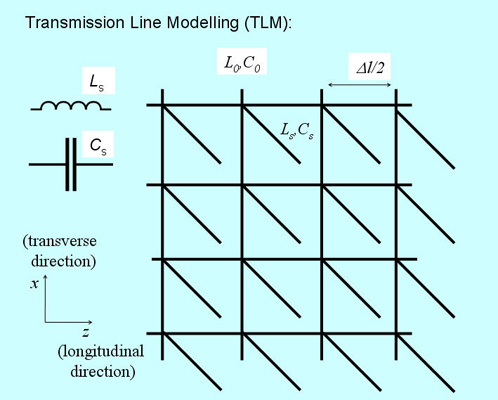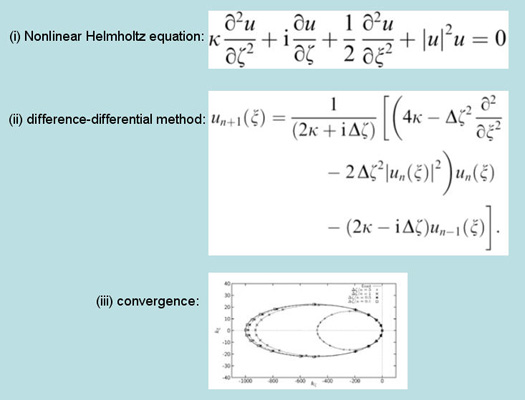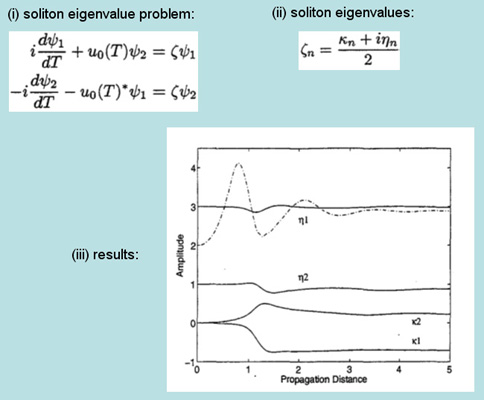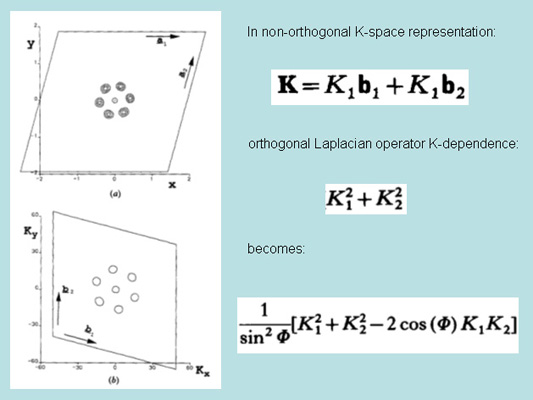Solitons - computational techniques
The work below includes descriptions of our methods to solve the nonlinear Helmholtz equation and the first non-orthogonal beam propagation method.
Computational Techniques: Transmission Line Modelling

|
| Transmission Line Modelling (TLM) of soliton evolution governed by the nonlinear Helmholtz equation. |
7. P Chamorro-Posada and GS McDonald, TLM modeling of Helmholtz soliton propagation, Nat Phot Conf, Photon 08, Edinburgh, UK, Aug, 2008
Abstract. The nonlinear Helmholtz (NLH) equation provides a more general framework for the study of nonlinear optical beams in which the paraxial restrictions of the nonlinear Schroedinger (NLS) equation are released. Helmholtz soliton theory now comprises an extensive collection of exact soliton solutions in a broad range of media as well as the identification and analysis of scenarios where highly nonparxial effects are originated strictly from angular considerations, such as interface effects or soliton interactions.
For the computational analyses, accurate numerical algorithms have been developed which are based on envelope representations of the NLH equations. The direct solution of the 2D Maxwell equations in the time domain using the transmission-line model (TLM) method provides an alternative route for the study of CW nonlinear optical beam propagation in nonlinear media. Though more computationally intensive, also provides full generality in terms of the regimes that can be addressed.
The results of our parallel implementation of the nonlinear TLM method confirm previous numerical and analytical results regarding Helmholtz soliton propagation. Also, an account of relevant issues of the TLM method for modelling nonlinear beam propagation, such as the effects of four-wave mixing or numerical dispersion, will be presented. Interestingly, it has been argued that the instability of subwavelength solitons of the scalar NLH equation is due to the elliptic nature of the envelope model equations. This is in contradiction with our analyses of the propagation model which identifies a numerical origin for those instabilities. The TLM analysis agrees with our predictions.
Computational Techniques: Nonlinear Helmholtz Equation

|
| Numerical solution of the nonlinear Helmholtz equation using the difference-differential method. |
6. P Chamorro-Posada, GS McDonald, GHC New, Non-paraxial beam propagation methods , OPTICS COMMUNICATIONS 192, p1, 2001
Abstract. Exact analytical results are employed in the testing of split-step and finite difference approaches to the numerical solution of the non-paraxial non-linear Schroedinger equation. It is shown that conventional split-step schemes can lead to spurious oscillations in the solution and that fully finite difference descriptions may require prohibitive discretisation densities. Two new non-paraxial beam propagation methods, that overcome these difficulties, are reported. A modified split-step method and a difference-differential equation method are described and their predictions are validated using dispersion relations, an energy flow conservation relation and exact solutions. To conclude, results concerning 2D (transverse) beam self-focusing, for which no exact analytical solutions exist, are presented.
Computational Techniques: Soliton Eigenvalues

|
| Fast algorithm for computing the parameters (eigenvalues) of the soliton components. |
5. P Chamorro-Posada, GS McDonald, GHC New and FJ Fraile-Pelaez, Fast Algorithm for Studying the Evolution of Optical Solitons under Perturbations, IEEE Trans Magnetics 35, p1558, 1999
Abstract. A numerical algorithm is proposed for computing the eigenvalues of the linear scattering problem associated with the nonlinear Schroedinger equation. The numerical method allows a fast calculation of the dynamical evolution of the properties of optical solitons under a wide range of perturbations.
4. P Chamorro-Posada, GS McDonald, GHC New and FJ Fraile-Pelaez, Fast Algorithm for Studying the Evolution of Optical Solitons under Perturbations, IEEE Conference on Electromagnetic Field Computation, Tuscon, USA, June 1-3, 1998.
3. P Chamorro-Posada, GS McDonald and GHC New, Nonparaxial Solitons: Accurate Numerical Methods and New Results (Invited), European Quantum Electronics Conference, Glasgow, UK, Sept 13-18, 1998.
Computational Techniques: Nonorthogonal Beam Propagation Method

|
| First beam propagation method (BPM) using nonorthogonal spatial grids. The grid angle Φ (between the basis vectors in real space) can be different from 90 degrees. |
2. GS McDonald, GP Karman, GHC New and JP Woerdman, Kaleidoscope Laser, J Opt Soc Am B 17, p524, 2000.
Abstract. We report the first calculations of mode patterns of unstable-cavity lasers with truly two-dimensional transverse geometries. A detailed account of numerical techniques, incorporating a nonorthogonal beam-propagation method, and results for cavities with a range of transverse symmetries, such as regular polygonal and rhomboid, are presented. In view of the beautiful complexity of the eigenmodes predicted, a novel kaleidoscope laser is proposed.
1. GS McDonald and WJ Firth, Spatial Grid Symmetries and Reduced Models in the Simulation of Beam Counterpropagation in a Nonlinear Medium, J Mod Opt 40, p23, 1993.
Abstract. In the context of the nonlinear interaction of counterpropagating light beams, we demonstrate the unrealistic symmetries that arise in the simulation of spontaneous pattern formation when using square computational grids. We have formulated a generalization of the split-step Fourier method which allows for non-orthogonal spatial grids. Implementation is shown to be simple and to entail negligible computational overheads. Results for two-dimensional Gaussian and extended cosine-bell input beam profiles are presented.